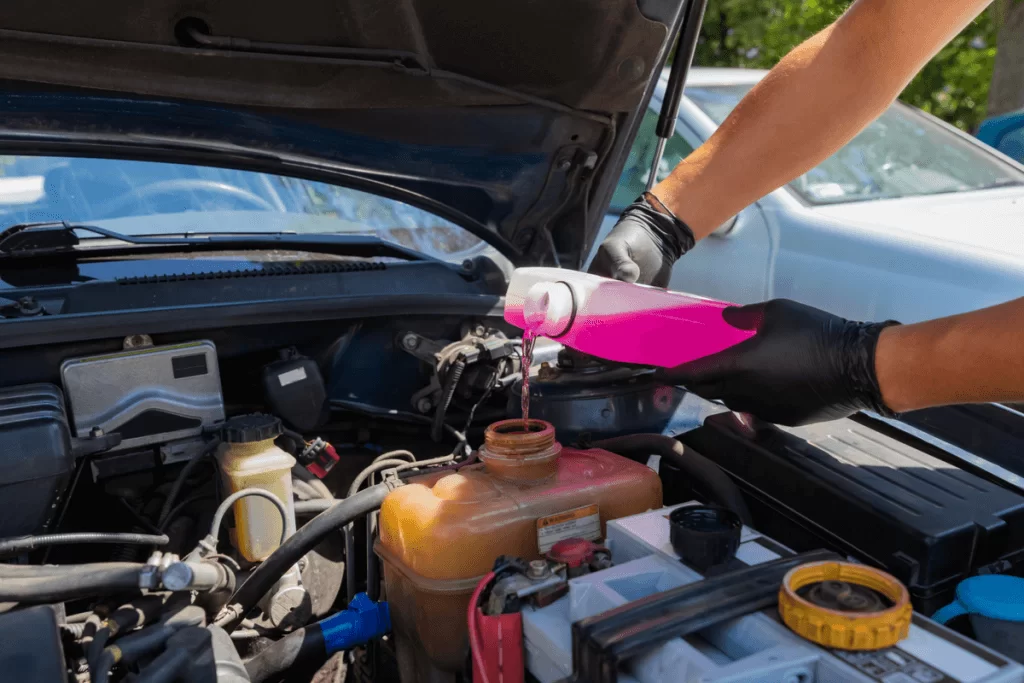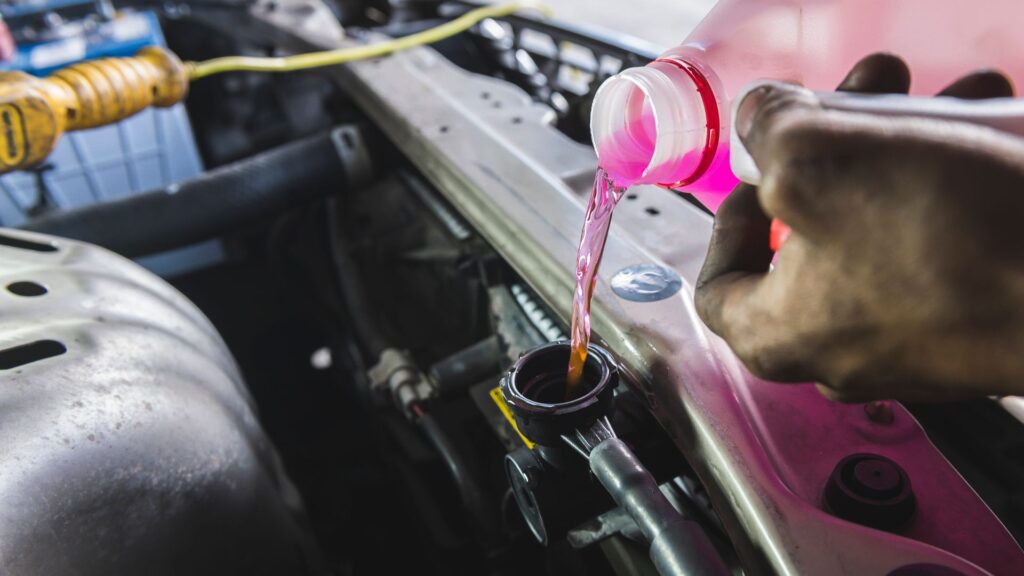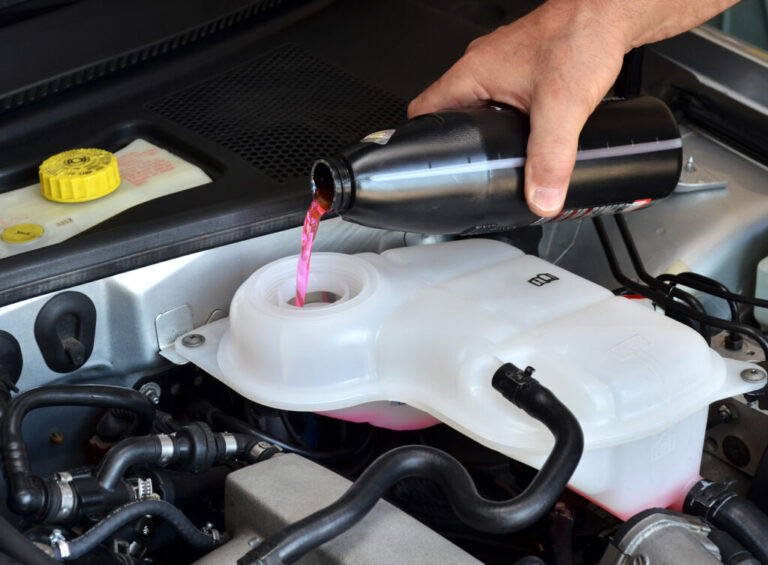One of your car’s important fluids is coolant. If you don’t have it, parts will overheat and damage your engine, requiring costly repairs.
However, Your car might use too much coolant for several reasons. Common causes include coolant leaks from issues like damaged hoses or gaskets, a failing head gasket, or problems with the engine block or cylinder head.
Also, incorrect coolant mixtures and extreme weather conditions can play a role, as well as towing heavy loads or leaving your engine idling for extended periods, which can cause it to work harder and use more coolant.
But Fear Not! Here you will learn more causes with the right solutions.
Symptoms of Excessive Coolant Consumption

Frequent Low Coolant Warnings: If your car’s low coolant warning light frequently comes on, even after topping off the coolant, it could be a sign of excessive consumption.
Engine Overheating: Continuous overheating of the engine is a clear indicator of cooling system problems. If the temperature gauge consistently rises into the red zone, this may be due to inadequate coolant.
Visible Coolant Leaks: Inspect the ground where you park your car. Puddles or stains of brightly colored coolant (typically green or orange) underneath the vehicle are a clear sign.
White Exhaust Smoke: A persistent presence of white smoke in the exhaust, particularly when the engine is warm. This may be due to a damaged head gasket.
Milky Engine Oil: If you notice that your engine oil has a milky appearance when you check the dipstick, it may indicate coolant mixing with the oil. This could result from a cracked engine block or a damaged head gasket.
Rapid Coolant Disappearance: Regularly needing to add coolant to the reservoir or radiator indicates a coolant consumption problem. If you’re losing coolant but not finding any external leaks, it might be going into the engine.
Reduced Heater Performance: If your car’s heater doesn’t provide adequate warmth or takes a long time to heat up, it could be due to insufficient coolant levels in the heating system.
Inconsistent Temperature Gauge: Fluctuations in the temperature gauge, especially during normal driving conditions, might suggest a problem.
Unusual Engine Noises: Gurgling or bubbling sounds coming from the engine could indicate air pockets in the cooling system.
Sweet Smell from Exhaust: If you notice a sweet, almost syrup-like smell coming from the exhaust, it could be an indication of combustion chamber and burning.
Possible Causes of Excessive Coolant Usage
- Coolant Leak: The most common reason for coolant loss is a leak. Check for visible signs of coolant under your car, which may indicate a leak in the radiator, hoses, water pump, or a gasket (like the head gasket). If you can’t find a visible leak, it might be internal, such as a head gasket leak.
- Radiator Cap Issues: A faulty radiator cap can cause to escape, as it won’t maintain the proper pressure in the cooling system. This can lead to coolant loss and overheating.
- Overheating: If your car is frequently overheating, it will evaporate more quickly. Overheating can be caused by a malfunctioning thermostat, a blocked radiator, or a failing water pump.
- Head Gasket Leak: A blown head gasket can allow coolant to enter the combustion chamber or mix with engine oil. This often results in white smoke from the exhaust, overheating, and a noticeable loss of coolant.
- Cracked or Damaged Components: Cracks in the engine block, cylinder head, or other cooling system components are responsible.
- Coolant Evaporation: Some loss is normal over time due to evaporation. However, if you’re constantly adding coolant, there may be a larger issue.
- Improper Coolant Mix: Make sure your system is correctly mixed with water. Using pure coolant without dilution can cause it to be less effective and may lead to overheating.
- Cooling System Obstructions: Obstructions in it, such as mineral deposits or debris can impede the flow.
- External Factors: Extreme weather conditions, such as extreme heat or cold, can cause the engine to work harder. Towing heavy loads or prolonged idling can also strain the cooling system
Repair and Maintenance
To address excessive coolant consumption, several essential steps should be taken. Firstly, if a coolant leak is detected, prompt replacement or repair of the damaged component is crucial. This may involve fixing leaking hoses, replacing a faulty water pump, or addressing a damaged radiator.
Additionally, in cases where a failing head gasket is identified as the root cause, it is imperative to replace the head gasket to prevent further coolant loss and potential engine damage.
Then, If a cracked engine block more extensive repairs or even engine replacement may be necessary, depending on the severity of the damage. For damage to the cylinder head, repairing or replacing the head is often required to prevent coolant loss.
Further, routine thermostat replacement is essential to ensure proper engine temperature regulation. If the radiator cap or pressure relief valve is faulty, replacing it is essential to maintain the proper pressure within the cooling system. After addressing the underlying issue, a comprehensive coolant system flush should be performed to remove contaminants, followed by refilling the system with the correct coolant mixture as per the manufacturer’s recommendations.
Prevention and Maintenance Tips
- Check the cooling system for leaks, corrosion, or damage to catch problems early.
- Keep levels in the reservoir and radiator at recommended levels to prevent overheating and coolant loss.
- Use the right coolant recommended by your vehicle’s manufacturer and avoid mixing different types.
- Stick to your car’s maintenance schedule, including its changes and system flushes.
- Keep an eye on the temperature gauge; if it runs too hot or cold consistently, investigate promptly.
- If you notice coolant leaks or engine overheating, or if it’s time to change hoses and belts as recommended in the maintenance schedule, act promptly to prevent further damage. Additionally, periodic coolant system flushes and replacements, following the manufacturer’s instructions, help maintain its effectiveness.
- Be cautious of extreme weather. Ensure it works well in hot weather, and use the right coolant mix in cold weather to prevent freezing.
- If you tow heavy loads or stress the engine, monitor the cooling system closely. You may want to consider an auxiliary transmission cooler for extra protection.
- Routinely inspect your parking area for coolant puddles, especially after driving, to catch leaks early.
Changing Car Coolant Safely and Effectively

- Begin by locating the coolant reservoir in your vehicle and carefully removing the reservoir cap.
- Examine the current coolant level in the reservoir to determine if it’s low or needs replacement.
- Prepare a 50/50 mixture of engine coolant and distilled water. This balanced mixture is vital for maintaining your engine’s temperature. Do not pour undiluted coolant directly into the reservoir.
- Gently pour the coolant mixture into the coolant reservoir, ensuring it reaches the recommended fill level. If you don’t have distilled water on hand, clean water can be used temporarily.
- Monitor the coolant level closely after adding the mixture, ensuring it stabilizes and doesn’t fluctuate.
- If you need to open the coolant reservoir for any reason, take safety precautions:
- Place a damp cloth over the reservoir cap to prevent hot coolant from splashing.
- Grasp the cloth-covered cap firmly to avoid direct contact.
- Slowly turn the cap and release it, as high pressure could push it upward. If there’s an immediate overflow, open and close the cap repeatedly until the system’s pressure subsides.
- After replenishing the coolant, inspect the connections and joints for any signs of leaks. Address any issues promptly.
- Start the engine and monitor the temperature gauge. If the needle remains within the safe range, you can continue your journey.
- If the temperature gauge indicates danger, allow the engine to cool for 15-20 minutes, then attempt to restart the vehicle.
- If the coolant reservoir continues to indicate a dangerous level or if you encounter any difficulties, it’s advisable to seek professional help or contact a mechanic for assistance.
FAQs
What if there is no leak?
If you’re losing coolant without any visible leaks, it’s likely being burned inside the engine, often due to a failed head gasket. The head gasket seals the engine and prevents coolant from entering the cylinders. Look for signs like an overheating engine, oil in the coolant, sludge under the oil cap, or white exhaust smoke. A mechanic can use specialized tools to confirm a blown head gasket without disassembling the engine.
How much coolant loss is normal?
In a sealed coolant system, some water content naturally evaporates due to high heat. Normally, you should lose no more than an ounce or two of coolant over 12 months. High-mileage drivers might experience slightly more, but it shouldn’t be noticeable. If you find yourself frequently topping up the coolant, it indicates a problem, such as a leak.
How often should you check your coolant level?
Check the coolant level regularly, ideally every month during routine maintenance checks. Look at the coolant tank, where there are minimum and maximum level markers. If it falls below the low marker, top up with a 50/50 mix of coolant and water. You can use a coolant strength tester or test strips to check the coolant’s concentration. In emergencies, you can top up with water, but be sure to adjust the concentration with the proper coolant as soon as possible.
How often should you need to add coolant?
You should check your engine coolant at least twice a year before summer and winter. However, the recommended frequency may vary between car manufacturers. Coolant should be topped up whenever the level drops below the guide marks.
Can I use water instead of coolant in an emergency?
Yes, In an emergency, if your coolant is really low or empty, you can add water to your radiator to get you to your destination. It’s ideal to use a 50/50 mix of coolant and water (or pre-mixed coolant) under regular circumstances.
What is the average life of coolant, and how often should it be flushed?
The average time between coolant flushes depends on the vehicle and the type of coolant. For silicated coolants, it’s typically every two years or 30,000 miles, while extended drain coolants can go up to five years or 100,000 miles between flushes. You can identify the type of coolant by its color.
Is it normal for a car to use a lot of coolant?
No, it’s not normal for a car to use a significant amount of coolant. Some minimal evaporation is expected, but substantial coolant loss is usually a sign of a problem.
Can coolant disappear without a leak?
Yes, coolant can vanish without visible leaks. If you’re losing coolant with no apparent external leak, it may indicate an internal issue like a failing head gasket or an engine problem.
Final Words
In conclusion, when your car uses too much coolant, it’s a sign of potential issues in the cooling system and engine. Symptoms like low coolant warnings, overheating, leaks, white smoke, or milky oil are warning signs.
Moreover, to fix the problem, you must quickly identify the specific cause, whether it’s leaks, a bad head gasket, or engine block problems. Regular maintenance and preventive measures are essential for a healthy cooling system. By following these steps and getting professional help when needed you can keep your vehicle running smoothly and avoid costly repairs or engine damage in the future.

